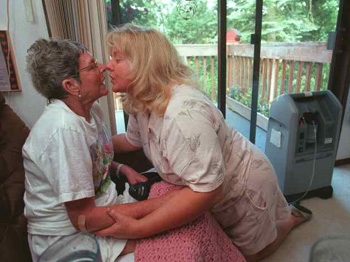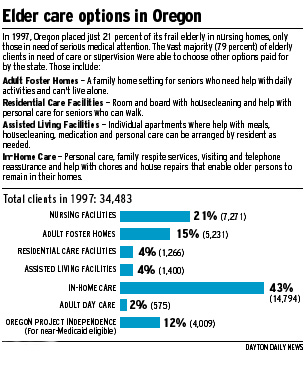Oregon offers elders choices
State helps pay for long-term care alternatives

|
© 1999 Dayton Daily News
PORTLAND, Ore. -- When it comes to delivering long-term care, the official state slogan -- "Oregon: Things Look Different Here" -- is more than just a Chamber of Commerce come-on.
Consider the following:
* When 89-year-old Hilda Gerges broke her hip in 1993, she and her husband, disabled with emphysema, were placed in a nursing home "where there was hardly enough room to walk between our beds," she said. With the help of their case manager, the couple soon relocated -- at state expense -- to a brand-new
|
Comfortable in her final days  LISA POWELL/DAYTON DAILY NEWS
Ginger Coleman (right) gives her mother, Mildred Caviness, a goodbye kiss after an afternoon visit at Hillside Home Adult Care in Lake Oswego, Ore. Caviness, who died a few weeks after this photograph was taken, spent her last days in the adult foster home run by Chris Peterson. Four other elderly women live with Peterson and her family. See sidebar.
LISA POWELL/DAYTON DAILY NEWS
Ginger Coleman (right) gives her mother, Mildred Caviness, a goodbye kiss after an afternoon visit at Hillside Home Adult Care in Lake Oswego, Ore. Caviness, who died a few weeks after this photograph was taken, spent her last days in the adult foster home run by Chris Peterson. Four other elderly women live with Peterson and her family. See sidebar.
|
* Four years ago, when Pat Kennedy could no longer care for his wife, Barb, as she entered the final, paralyzing stages of Lou Gehrig's disease, the couple decided against sending her to a nursing home, even though she could no longer breathe without the help of a ventilator. With state financial support, Barb was placed in an adult foster home, where she is one of five ventilator patients cared for by two specially trained nursing assistants. The Kennedys believe that the extra attention at the foster home has added years to Barb's life.
Welcome to Oregon, where the state not only offers a variety of alternatives to nursing-home care, it's also willing to pay for them.
"Any type of living situation you can come up with -- anything that will work for the client -- we'll try to come up with a way to support it, as long as clients are safe and their needs are taken care of," said Fritz Stephens-Tiley, manager of the Tigard Senior Resource Center just outside of Portland.
To a degree unmatched by other states, Oregon's long-term care system serves more of its elderly at home and in other community-based settings than it does in nursing homes. This year, only one in five of the state's 34,483 long-term care clients will be cared for in a nursing home.
The vast majority (79 percent) will be helped either at home or in other substitute living arrangements in the community. They may be placed in assisted-living facilities, where clients receive personal care in their own apartments, or adult foster homes, where they can live in a small, homelike setting with their caregivers.
As one Oregon official put it, nursing homes are viewed "as a last resort . . . In most cases, you have to be totally bedridden to be placed there."
The Oregon approach is not without controversy. Meredith Cote, who heads the state's long-term care ombudsman program that investigates complaints about elder care, believes Oregon has relied too heavily on adult foster homes, which care for five or fewer residents. The homes are more difficult to monitor, she said, because they are scattered throughout the state and because operators don't like to be disturbed at odd hours for inspections.
 "It's a challenge just to know what's going on in these homes," Cote said. "Over and over and over again, providers have been known to leave residents in the hands of unqualified caregivers. They're not doing enough tracking of criminal backgrounds, for one thing."
"It's a challenge just to know what's going on in these homes," Cote said. "Over and over and over again, providers have been known to leave residents in the hands of unqualified caregivers. They're not doing enough tracking of criminal backgrounds, for one thing."
Oregon has a population of about 3 million, compared to Ohio's 11.1 million, making comparisons difficult. However, the ratio of nursing home to in-home patients supported by the state in Ohio is just the reverse of Oregon. Ohio pays for nearly 79,000 residents in nursing homes but for fewer than 20,000 receiving in-home care. Ohio will not pay for adult foster homes, assisted living, adult day care or relatives who care for loved ones at home.
Robert Applebaum, an expert on aging issues at the Scripps Gerontology Center of Miami University, said Ohio could learn a lot from the Oregon philosophy of offering more care choices to the elderly. But as a larger, more urban state, Ohio may have trouble developing parts of the Oregon system, especially the adult foster home program, he said.
"In smaller towns and rural areas where you have adult foster care, there's more knowledge of the people in the system," Applebaum said. "In larger urban areas, it's easier for people to get lost in the system."